Join Us for a Significant Seeds ‘Smoko’
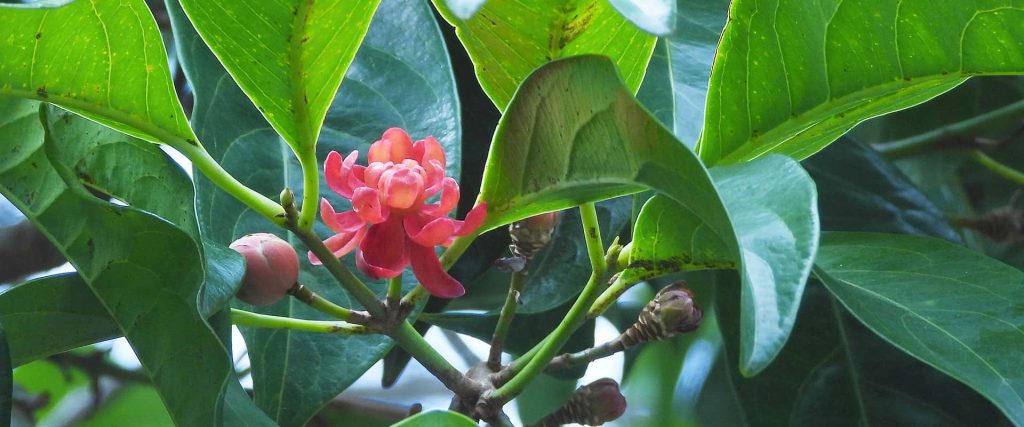
Flowering Idiospermum australiense, each bloom may form into a distinctive seed.
Hi there,
Thanks for joining us. We’re taking a break on an early morning seed-collecting trip near Noah Creek. This is a lowland creek valley surrounded by steep rainforest slopes. There are lots of trees fruiting in the area so it’s the perfect time to target a few species. We don’t have a ‘seed bank’ at the nursery as many rainforest seeds are not viable for long periods of time. They hit the soil and get growing, or don’t grow at all.
In the time it takes us to have our ‘smoko’, we’ll get you up to speed on the significance of four seeds that cover millions of years of plant evolution. Take a look at them in the pictures as we go.
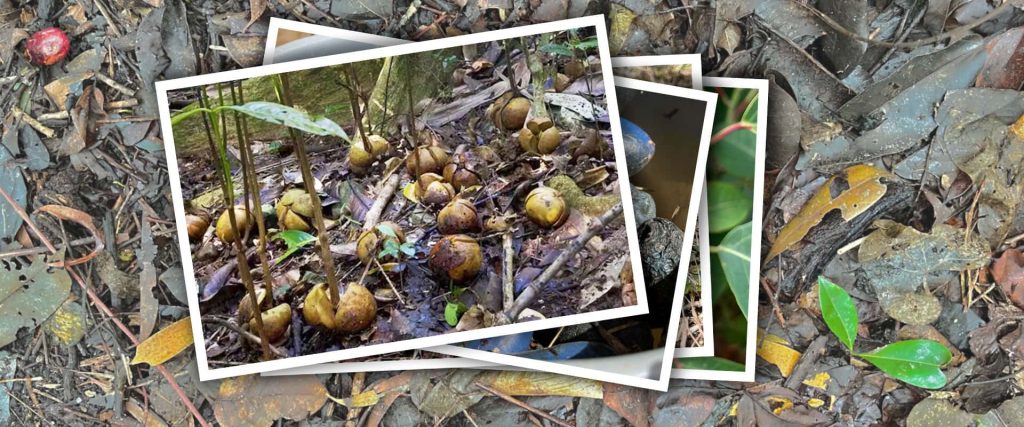
The first seed is Idiospermum australiense or ‘Idiot Fruit’. These curious looking seeds are a relic species; the mature trees may not look like much but they’re incredibly significant in the plant record.
Fossils of plants that are almost identical to Idiospermum were growing in the ancient Gondwanan forests, over 120 million years ago. That’s an extraordinary timescale!
The seeds are unusual as they have multiple cotyledons, which are the embryo leaves within the seed. Other flowering plants only have one or two. When the berries fall, they’ve lost all their fruiting layers, so they land on the ground as these huge naked seeds. They look like billiard balls from another world. In fact, you could say they were, as Idiospermum was discovered twice by scientists! The second time was only fifty years ago, after a herd of cows were mysteriously dying off near Cow Bay, just down the road from here.
The seeds are very toxic, it’s unlikely that any animals are going to pick them up and carry them anywhere. Remember, Idiospermum evolved before cassowaries and seed-eating mammals, maybe a dinosaur could withstand the toxicity. Right now, they’re all dispersed by gravity, so they only grow in very condensed areas and would rely on rain and flooding to expand their range.
Now, we don’t collect or grow Idiospermum seeds in the nursery, for two reasons. One, they’re a protected species – we’d need a government permit to grow them. And two, despite being around for a long time, they’re not going to help us ‘grow a rainforest’ in the Daintree because of their restricted dispersal techniques.
Instead, that’s why our next seed is of significance.
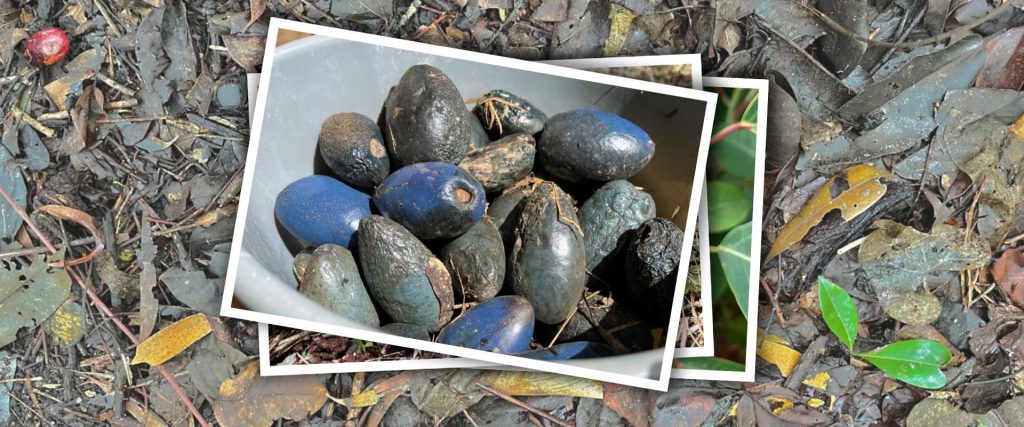
So, these blue beasts are Cerbera floribunda, the fruit of the Cassowary Plum or Grey Milkwood. Like the Idiospermum, they’re toxic, but there’s one species which obviously loves to eat them. Cassowaries.
The tree has a symbiotic relationship with the birds, considering Cassowaries have been roaming the forest for 60 million years, that’s a long-held connection. So, Cassowaries will swallow these big blue fruits whole, they’ll digest the thin flesh and then poop them out in one piece. The seeds are then dispersed across the forest, allowing new trees to grow away from their parent plant.
Contrary to popular belief, Cassowary Plums can germinate fine without a Cassowary. We grow them in our nursery, having scratched or rotted away the flesh to give them a head start. The seeds are huge, just one in each fruit. Inside each seed is a lot of nutrition, so the young plants are going to grow very quickly.
We’re big fans of Cassowary Plums. They’re one of our foundation species in rainforest restoration. They’re fast to grow and assist with canopy closure, so other slower growing species can begin to grow in the soil where the weeds and grass have been shaded out.
Within a few years the Cassowary Plum trees will flower for the first time, that’s a sign the next generation of trees will soon emerge. This means we’re achieving natural succession, and the rainforest is starting to manage its own restoration.
In that way, they’re similar to the next seed, which is another Cassowary favourite.
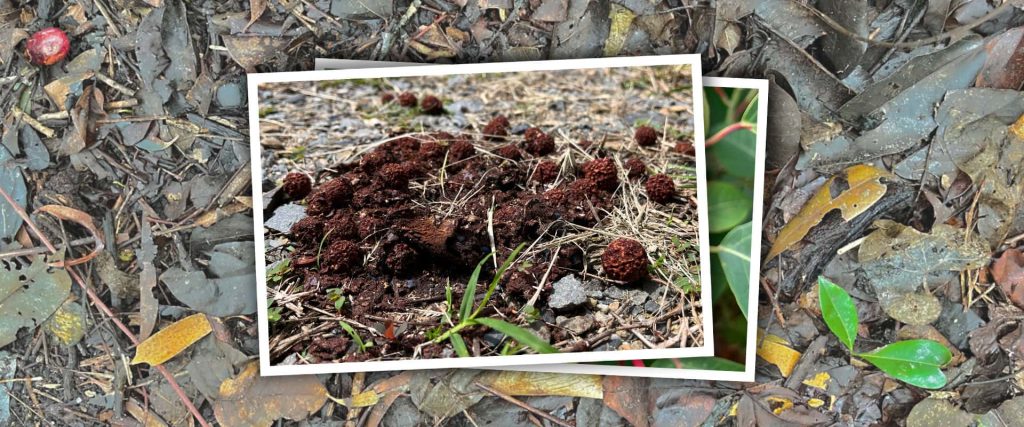
What we have next is another tree that has appeared in the fossil record for at least 40 million years. Compared to the previous two, this one is a versatile plant with several adaptations for species survival.
You’re looking at the seeds of Elaeocarpus grandis, the Blue Quandong. These appeared the other day on one of the tracks through the nursery, in a patch of fresh cassowary poop. All the fruit flesh has been digested and we’re left with these super-tough little nuts that look a bit like a shrunken walnut.
Unlike the previous species, these fruits are edible and they’re good bushtucker too. You’ll find a lot of different frugivore bird species get into these when they’re fruiting – Catbirds, Wompoo Pigeons and fruit-doves, while those that have fallen on the ground are good for Brush Turkeys and Cassowaries. The endangered Spectacled Flying-fox will eat them too, so there’s a huge range of seed dispersers.
Blue Quandong are usually found along watercourses and the little nuts can get carried far and wide. You often find them on beaches where they’ve washed up.
We love them as a restoration species. Each nut has several seeds inside, meaning we get multiple chances of new growth, and they are ridiculously fast-growing. We’re talking 6m in 10 months, and there are trees a decade old on one of our reveg sites that are well over 25m high! So, they’re perfect for canopy closure and high propagation success.
Pair them with the next tree and you’ve got an ideal ‘restoration pack’.
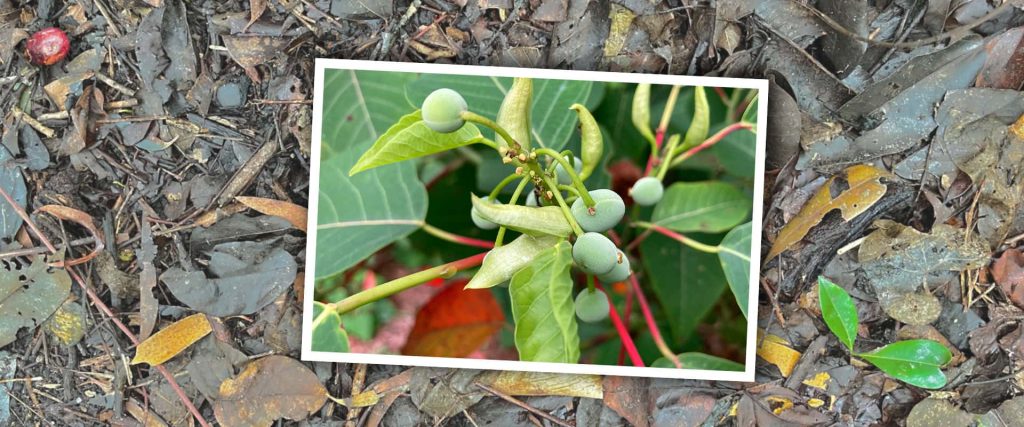
The last seed we want to share with you comes from a plant that is easy to identify. You just need to look for the red leaf amongst the green, like the one in the picture. These are Homalanthus novoguineensis or ‘Bleeding-Heart’. They’re from the Euphorbia family, with a lengthy fossil record.
The big heart-shaped leaves are a giveaway for the name, the red ones are those that are dying off or senescing, which is a natural part of the leaf cycle.
When it comes to the seeds, they have a few strategies for survival which makes them a key restoration candidate. Firstly, the seeds are surrounded by an oily coating or aril. The Brown Cuckoo-Dove is a fan of these, so again there’s a good chance of seed dispersal over a wide area. Then, once the Bleeding-Heart seeds reach the ground, they’re resilient little things. They remain viable in the soil for a long time, waiting months for a patch of sunlight to stir them from dormancy.
In that way, Bleeding-Hearts can create ‘seed banks’, ready for when a forest giant collapses and clears a space for new growth. If you come across a disturbed area of forest, you’ll find Bleeding-Heart will be one of the first species to take advantage. The seeds send out their shoots quickly and they grow fast with big broad leaves to capture as much sun as possible. You’ll notice that they have dense foliage too, a great advantage for a ‘pioneer’ species and for producing new soil biomass when those red leaves drop to the ground.
Like the other seeds we’ve looked at today, the Homalanthus genus has prehistoric roots. But we view Bleeding-Heart as a very modern seed too, because large areas of disturbed rainforest requiring healing are a recent trend. So that’s why Bleeding-Heart is an essential part of our repair kit.
There you go. Well over a hundred million years of plant evolution in a few minutes! You can see why it’s important to select certain species for our restoration work, so we focus on finding suitable parent plants to monitor for seed collection.
Well, it’s time to get back to work. Hope that was a good ‘smoko’ break for you too.
Rainforest Rescue’s Seed Collectors & Nursery Team
Want more good Rainforest news in your life?
Subscribe to our eNews | Follow us on Instagram | Like us on Facebook | Subscribe to our YouTube channel
Help Protect Rainforests Forever
Donate to Protect Rainforests Forever | Become a Rainforest Guardian for as little as $2 a month | Partnership Options

